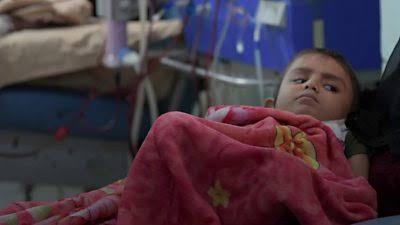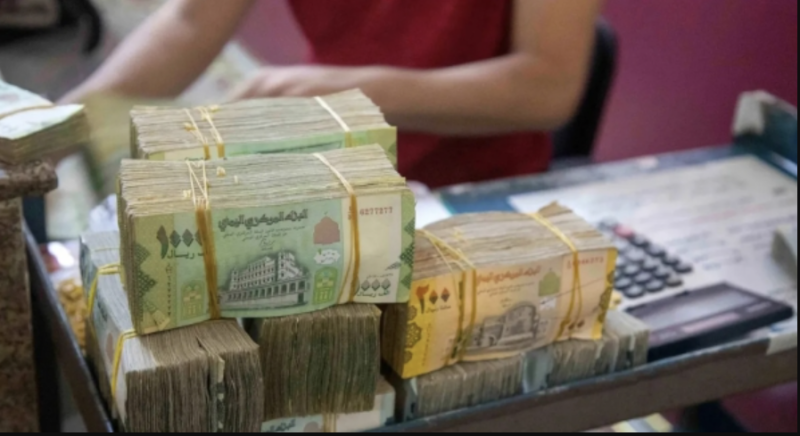Yemeni children's plight deepens as globe marks World Children's Day


As the globe marks World Children's Day on Friday, Yemeni children are suffering from hunger, poverty and disease amid the COVID-19 pandemic in the war-torn country.
"We have been warning for several months that Yemen was heading towards a cliff," said Jens Laerke, spokesman for the Office for the Coordination of Humanitarian Affairs.
"We are now seeing the first people falling off that cliff," Laerke said, referring to the war-inflicted Arab country's younger generation.
During what the United Nations says the largest humanitarian crisis in the world, children in Yemen are the most vulnerable.
MALNUTRITION
When Mohammed Hassan was transferred to the Al-Sabeen Hospital in the rebel-held Sanaa, the 15-year-old boy weighed only 14 kilograms.
He suffered acute malnutrition for years because his family was never able to put enough food on the table since the starting of the war.
"My children and I are hungry... our daily meal is dry bread and sometimes we do not get it. The war and blockade have devastated our life. We live now in a tenet with very little food," Hassan's father lamented.
Hassan's family was one of the thousands of Yemeni families that become unable to secure one meal a day or rent a house as food prices are rising and the value of the country's currency is falling because of the civil war.
About one-third of the Yemeni families have gaps in their diets, and hardly ever consume foods like pulses, vegetables, fruit, dairy products, or meat, according to the World Food Program.
The malnutrition rate among Yemeni children has soared to the highest level ever recorded.
The United Nations estimated that 7.4 million people in Yemen need nutrition assistance, and 2 million of them are children under the age of five.
In parts of Yemen, as many as 20 percent of the children under five are acutely malnourished.
COLLAPSING HEALTH SYSTEM
With nearly half of the health facilities in Yemen closed down, the other half is now barely functional as their operation almost completely relies on international aid.
The humanitarian aid is quickly draining off. According to the United Nations, 15 of its 41 major programs in Yemen have been reduced or shut down for lack of funds and the humanitarian response plan for Yemen is only 38 percent funded.
The surging malnutrition rate and a shattered health care system is a catastrophic combination. Yemen is now becoming a living hell for the country's children.
Many families face a cruel and painful choice: to use the little money they have to treat the ailing children or to buy food and save the lives of the whole family.
Having limited access to sanitation and clean water, children here have fallen easy prey to deadly epidemics, including cholera, malaria, dengue fever, and the novel coronavirus.
Although Yemen has only reported about 2,000 COVID-19 cases, it has a death rate of 25 to 30 percent, one of the highest in the world. The United Nations Children's Fund (UNICEF) warned that the COVID-19 pandemic in Yemen is "an emergency within an emergency."
EDUCATION
The United Nations said that the war in Yemen has damaged or destroyed more than 2,500 schools and forced 2 million children out of school.
Many students have not been able to return to their schools for more than five years. Those who are lucky enough to go back often have to study in straw-roof huts or even under trees because the war has destroyed most of the school buildings.
But what's worse than the shortage of classrooms and textbooks is the lack of teachers. Many teachers were displaced during the war and those who stayed did not get paid for years.
A recent UN statement pointed out that thousands of Yemeni teachers have not received salaries since the eruption of the war. Many of the teachers have sought other works to survive.
"Children out of school face increased risks of all forms of exploitation including being forced to join the fighting, child labor, and early marriage," the United Nations Children's Fund has warned.
CHILD LABOR
The war and blockade have caused the collapse of the country's economy and the local currency, forcing millions of children to go to hard labor in order to help their families survive.
Adel Rabie, 13, should be in school. Instead, he works at a market in the Hajjah province in northern Yemen, trying to earn a living.
Adel says he tries to earn around two U.S. dollars a day to buy some food for his mom and his little sisters living in a tent at a camp for the families, displaced by war from the northern border villages. Adel's father died at the beginning of the war.
Labor is an everyday reality for around 23 percent of children between 5 and 14 years old in Yemen. They are vulnerable to exploitation, sexual abuse, and forcible recruitment to war.
The United Nations even documented thousands of child soldiers in the country, most with the Houthi militia but also with the Yemeni government and other armed groups.
Despite all disasters, the resilience and fortitude of Yemenis also provide some hope. We see parents help schools to build classrooms, doctors offer free treatment for poor families, charity bakeries give out free bread, and so on.
But if the international community does not act quickly, such hopes will also die out. It's down to the world now to whether rekindle those hopes or watch the whole younger generation of Yemen slid into abysmal despair.

Paris — The French humanitarian organization Acted announced that it has delivered cash assistance to nearly 89,000 people affected by displa…

Sana’a — Fuel and food imports into ports under the control of Yemen’s Houthi movement on the Red Sea have continued to fall for…

ADEN — Yemen Airways, the country’s national carrier, announced it will resume flights between Aden and Abu Dhabi beginning in January…